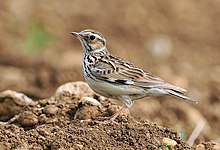Woodlark
| Woodlark | |
|---|---|
 |
|
| Scientific classification | |
| Kingdom: | Animalia |
| Phylum: | Chordata |
| Class: | Aves |
| Order: | Passeriformes |
| Family: | Alaudidae |
| Genus: | Lullula |
| Species: | L. arborea |
| Binomial name | |
|
Lullula arborea (Linnaeus, 1758) |
|
| Subspecies | |
|
see text |
|
| Synonyms | |
|
|
see text
The woodlark or wood lark (Lullula arborea) is the only extant species in the lark genus Lullula. It is found across most of Europe, the Middle East, western Asia and the mountains of north Africa. It is mainly resident (non-migratory) in the west of its range, but eastern populations of this passerine bird are more migratory, moving further south in winter.
There are two subspecies of woodlark, L. a. arborea and L. a. pallida. The former is native to northern regions of Europe, while the latter can be found in the south of the woodlark's range. Their diet is mostly composed of seeds but also includes insects during the breeding period. A comparatively small bird, the woodlark is between 13.5 and 15 centimetres long and roughly 20% shorter than the skylark. It is a brown bird with a pale underside and has a white-tipped tail.
The woodlark was originally placed within the genus Alauda until re-classified to the genus Lullula. The current genus name is onomatopoeic from French “Lulu”, the name given to the bird by de Buffon. The French name, Alouette lulu, and the scientific name, Lullula arborea, are derived from the sound of its song. The specific arborea is from Latin arbor, arboris, "tree".
There are two subspecies of woodlark:
This is a 13.5- to 15-cm-long bird, slightly smaller than the skylark being roughly 20% shorter. The woodlark is mainly brown above and pale below, but with a distinctive white superciliar meeting on the nape. It has a crest which is quite small and at most times inconspicuous. In flight it shows a short tail and short broad wings. The tail is tipped with white, but unlike the skylark, the tail sides and the rear edge of the wings are not edged with white.
A songbird, the woodlark has a melodious, warbling song often described onomatopoeically as a lu-lu-lu- or, more precisely, as a "serial lū-lū-lū-lū-lū-", toolooeet toolooeet toolooeet.
Found mainly in Europe, the mountains of northern Africa and western Asia, the woodlark is present across much of its range. In Europe, the bird seems most at home in the sandy heaths of Belgium, where its density was 7.5 pairs per square kilometre (km2) in 1988. In the same year, densities in East Germany ranged from 0.29 to 5.0 pairs per km2 and between 0.1 and 0.25 pairs per km2 in southern England, with more optimal habitats being more densely populated. However, populations fluctuated across Europe in the 1990s and 2000s and more up-to-date density figures are unavailable. The extent of the woodlark's range is England in the west, parts of northern Egypt to the south, Iran and Turkmenistan to the east and the Scandinavian Peninsula in the north. Declining populations have resulted in the woodlark's range contracting, for example in Britain it once bred in Wales and central England but is now found only in southern England. Within its range it is mainly resident in the west, with eastern populations migrating south in the winter.
...
Wikipedia

